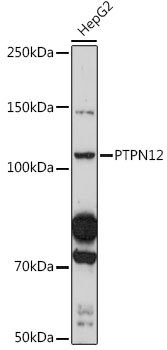PTPN12 antibody [N1N2], N-term
GTX102542
ApplicationsImmunoFluorescence, Western Blot, ImmunoCytoChemistry, ImmunoHistoChemistry, ImmunoHistoChemistry Paraffin
Product group Antibodies
TargetPTPN12
Overview
- SupplierGeneTex
- Product NamePTPN12 antibody [N1N2], N-term
- Delivery Days Customer9
- Application Supplier NoteWB: 1:1000-1:10000. ICC/IF: 1:100-1:1000. IHC-P: 1:100-1:1000. *Optimal dilutions/concentrations should be determined by the researcher.Not tested in other applications.
- ApplicationsImmunoFluorescence, Western Blot, ImmunoCytoChemistry, ImmunoHistoChemistry, ImmunoHistoChemistry Paraffin
- CertificationResearch Use Only
- ClonalityPolyclonal
- Concentration0.93 mg/ml
- ConjugateUnconjugated
- Gene ID5782
- Target namePTPN12
- Target descriptionprotein tyrosine phosphatase non-receptor type 12
- Target synonymsPTP-PEST, PTPG1, tyrosine-protein phosphatase non-receptor type 12, protein-tyrosine phosphatase G1
- HostRabbit
- IsotypeIgG
- Protein IDQ05209
- Protein NameTyrosine-protein phosphatase non-receptor type 12
- Scientific DescriptionThe protein encoded by this gene is a member of the protein tyrosine phosphatase (PTP) family. PTPs are signaling molecules that regulate a variety of cellular processes including cell growth, differentiation, mitotic cycle, and oncogenic transformation. This PTP contains a C-terminal PEST motif, which serves as a protein-protein interaction domain, and may regulate protein intracellular half-life. This PTP was found to bind and dephosphorylate the product of the oncogene c-ABL and thus may play a role in oncogenesis. This PTP was also shown to interact with, and dephosphorylate, various products related to cytoskeletal structure and cell adhesion, such as p130 (Cas), CAKbeta/PTK2B, PSTPIP1, and paxillin. This suggests it has a regulatory role in controlling cell shape and mobility. Alternative splicing results in multiple transcript variants encoding distinct isoforms. [provided by RefSeq]
- Storage Instruction-20°C or -80°C,2°C to 8°C
- UNSPSC12352203







